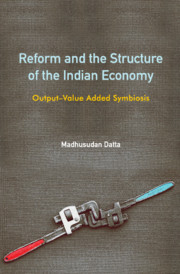Book contents
- Frontmatter
- Dedication
- Contents
- Tables
- Figures and Box
- Preface
- 1 Introduction: The Take-off
- 2 Growth and Structural Change since 1978–79: Issues in Measurement
- 3 Sectoral Shares in Indian GDP: How to Regard It?
- 4 Sectoral Growth: GVA–Output Dichotomy
- 5 Manufacturing Sector in the Indian Economy: Paradox of Growth and Stagnation
- 6 Growth and Sectoral GVA Adjustments
- 7 Demand for Intermediate Services
- 8 Linkages and Key Sectors in the Indian Economy
- 9 Conclusion: A Perspective of Indian Economic Growth
- References
- Index
4 - Sectoral Growth: GVA–Output Dichotomy
Published online by Cambridge University Press: 17 March 2020
- Frontmatter
- Dedication
- Contents
- Tables
- Figures and Box
- Preface
- 1 Introduction: The Take-off
- 2 Growth and Structural Change since 1978–79: Issues in Measurement
- 3 Sectoral Shares in Indian GDP: How to Regard It?
- 4 Sectoral Growth: GVA–Output Dichotomy
- 5 Manufacturing Sector in the Indian Economy: Paradox of Growth and Stagnation
- 6 Growth and Sectoral GVA Adjustments
- 7 Demand for Intermediate Services
- 8 Linkages and Key Sectors in the Indian Economy
- 9 Conclusion: A Perspective of Indian Economic Growth
- References
- Index
Summary
I only took the regular course … different branches of Arithmetic – Ambition, Distraction, Uglification and Derision.
—‘The Mock Turtle's Story’, in Alice's Adventures in Wonderland (Carroll, c. 1930)Introduction
Sustained and rapid growth of GDP with a steadily declining share of agriculture and a stagnant share of manufacturing inevitably draws one's attention to the service sector. Our discussion in Chapter 3 has shown that given the state of development of the Indian economy in 1981, the performance of the service sector, when judged by gross value added (GVA), was quite below the average by the yardstick of the global development experience. However, the sector subsequently performed well so that in the course of the next two decades it surpassed the K-CT norm1 by far to become an outlier, and thereafter further strengthened its position as a super-performer in 2011. Just the reverse is true of the industry sector by the same yardstick. The manufacturing sector, which is supposed to be the mainstay of industry, did not show a spur; the rising trend of the past decades of its relative share flattened out after the turn of the 1970s. By the global standard, the sector’s performance judged by GVA was far below the norm insomuch as it qualified as an underperforming outlier in 2001 and almost so in 2011. This has been the case in spite of all product market reforms, discussed earlier, aimed at boosting the sector. Since manufacturing ability is a reflection of the stock of productive knowledge amassed by a country, the apparent stagnancy in manufacturing has caused some dismay and serious reflection. In this backdrop, the rapid growth of the economy has been judged to have been made possible by the impressive growth of the service sector; the observation is statistically incontrovertible.
But what were the services that grew and what were the more dynamic components of the sector? A fundamental question is about the relevance of gross value added (GVA) as a measure of the level of activity in a sector. Value added is a monetary measure and it has a lot to do with the movement of relative prices, which may be caused by either the demand side or the supply side.
- Type
- Chapter
- Information
- Reform and the Structure of the Indian EconomyOutput-Value Added Symbiosis, pp. 53 - 69Publisher: Cambridge University PressPrint publication year: 2020



